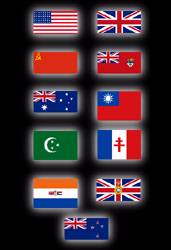
The Allied Powers were any countries who officially fought against the Axis
Powers. The Major Allied Powers were the United States, Soviet Union, Great
Britain and its Empire, France, and China. Numerous smaller nations also
fought with the Allied Powers.
Chaing Kai Shek - (China)
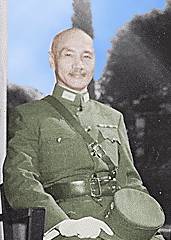
Chiang Kai-shek joined the military at an early age and participated in the
overthrow of the Ch'ing Dynasty. He opposed communism, and in 1928, became
head of the Nationalist Government, and dedicated himself to suppressing
Chinese Communists.
Chiang Kai-shek was unable to stop the Japanese invasion of Manchuria in 1931,
and in 1937, he was forced to work with Chinese Communists when Japan invaded
China. After the Second World War ended, Chiang Kai-shek led the Nationalist
Government in a Civil War against the Communist led by Mao Tse-tung. The
Nationalists were forced from China to Taiwan, where Chiang Kai-shek died in
1975.
Winston Churchill - (Great Britain)
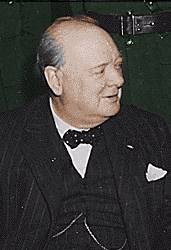 Winston
Churchill became Prime Minister of Great Britain in 1940, replacing the
ineffective Neville Chamberlain. As war leader in Britain, Churchill helped
the Soviet Union when Germany launched its invasion of the communist country
in 1941, and he forged a strong, personal relationship with United States
President Franklin Roosevelt, from whom Britain received much needed aid in
the early years of the conflict and before America was officially at war with
Germany or Japan.
Winston
Churchill became Prime Minister of Great Britain in 1940, replacing the
ineffective Neville Chamberlain. As war leader in Britain, Churchill helped
the Soviet Union when Germany launched its invasion of the communist country
in 1941, and he forged a strong, personal relationship with United States
President Franklin Roosevelt, from whom Britain received much needed aid in
the early years of the conflict and before America was officially at war with
Germany or Japan.
Churchill and Roosevelt developed much of the strategy for the allies during
the war. He met with Roosevelt and Soviet Premier Josef Stalin at Teheran and
Yalta to discuss both strategy and the division of Europe and Germany after
the end of hostilities.
Churchill helped the Russians during the war, he was a fervent opponent of
communism. He wanted the allies to beat the Soviets to Berlin in the last
months of the war to prevent them from occupying the city, but larger war aims
prevented that action.
Churchill was voted out of office in 1945, after Germany's surrender and while
he was attending the Postdam Conference in Germany. He was replaced by Clement
Attlee. However, Churchill was again elected Prime Minister in 1951 and served
until 1955. He died in 1965.
Franklin Delano Roosevelt - (United States)
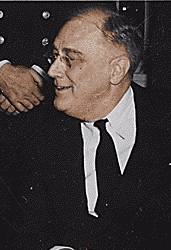 In
1941, when the United States was drawn in to World War II with the sneak
attack on Pearl Harbor by the Japanese, President Franklin Roosevelt was in
the 1st year of an unprecedented third term as President. After the attack on
Pearl Harbor, Roosevelt addressed Congress, giving one of his most famous
speeches, in which he said, "we have nothing to fear but fear itself."
In
1941, when the United States was drawn in to World War II with the sneak
attack on Pearl Harbor by the Japanese, President Franklin Roosevelt was in
the 1st year of an unprecedented third term as President. After the attack on
Pearl Harbor, Roosevelt addressed Congress, giving one of his most famous
speeches, in which he said, "we have nothing to fear but fear itself."
During the War, President Roosevelt met with Winston Churchill, Prime Minister
of Great Britain, and Josef Stalin, Premier of the Soviet Union at Teheran and
Yalta, and with Churchill and Chiang Kai-shek, President of China, in Cairo.
Roosevelt, along with Churchill, set much of the allies' military strategy and
urged the creation of a United Nations to help prevent future wars of the
magnitude of World War II.
The pressures of the war took a heavy tool of Roosevelt's health, and on April
12, 1945, while serving his fourth term as president, he died. His
vice-president, Harry S. Truman, who saw the United States through the end of
the war, succeeded him.
Josef Stalin - (Soviet Union)
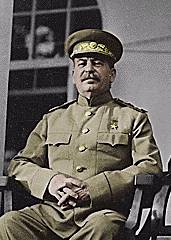 Josef
Stalin, the Soviet Union's war leader during World War II (the Great Patriotic
War to the Soviets), came to power after the death of Vladamire Lenin in the
late 1920s. He was a harsh and brutal dictator. In 1937-38, he purged his
military of its best officers, an act that would deprive him of competent
leadership once the war started. In 1939, Stalin and Adolf Hitler signed the
Nazi-Soviet Non-aggression Treaty that, besides declaring one country would
not go to war with the other, divided Poland between Germany and the Soviet
Union.
Josef
Stalin, the Soviet Union's war leader during World War II (the Great Patriotic
War to the Soviets), came to power after the death of Vladamire Lenin in the
late 1920s. He was a harsh and brutal dictator. In 1937-38, he purged his
military of its best officers, an act that would deprive him of competent
leadership once the war started. In 1939, Stalin and Adolf Hitler signed the
Nazi-Soviet Non-aggression Treaty that, besides declaring one country would
not go to war with the other, divided Poland between Germany and the Soviet
Union.
When the Germans launched Operation Barbarossa (its invasion of the Soviet
Union) in 1941, Josef Stalin was caught completely off guard and caused him to
have a nervous breakdown.
However, Stalin recovered and was able to rally his country in an effort to
stop the Germans, which they did, but not before the Nazis had advanced as far
as the outskirts of Moscow.
In 1942, Stalin issued Order No. 227, which forbade the giving-up of any more
territory to the Germans. Like the purges, though, Order No. 227 cost him a
tremendous amount of men. Stalin received aid in the form of tanks, planes,
foodstuffs, and more from the other allies, particularly America and Britain.
He met with President Roosevelt and Winston Churchill at Teheran and Yalta and
with President Harry Truman and Clement Attlee at Postdam in 1945.
After the war in Europe ended, Stalin continued his brutal methods, killing
any and all who opposed him, both in Russia and Eastern Europe. Stalin died in
1953.
Dwight D. Eisenhower - (United States)
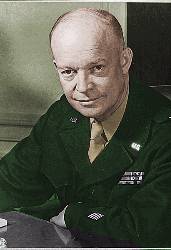 Dwight
D. Eisenhower graduated from West Point Military Academy in 1915 and rose
quickly through the ranks of the United States Army. At the outbreak of World
War II, Eisenhower was named Chief of Staff to George C. Marshall. In 1942,
Marshall sent Eisenhower to Great Britain to command American forces there and
in Europe. He commanded the North African Landings (Operation Torch), the
Normandy Invasion (Operation Overlord), and the offensive against Germany in
Western Europe.
Dwight
D. Eisenhower graduated from West Point Military Academy in 1915 and rose
quickly through the ranks of the United States Army. At the outbreak of World
War II, Eisenhower was named Chief of Staff to George C. Marshall. In 1942,
Marshall sent Eisenhower to Great Britain to command American forces there and
in Europe. He commanded the North African Landings (Operation Torch), the
Normandy Invasion (Operation Overlord), and the offensive against Germany in
Western Europe.
He, like the rest of the allies, were caught off guard with Germany's
offensive in the Ardennes (Battle of the Bulge) but recovered and led the
allies into Germany the following spring.
After the war, Eisenhower served a stint as Army Chief of Staff, and in 1952,
he ran for President of the United States as a Republican, serving two terms.
He died in 1969.
Douglas MacArthur - (United States)
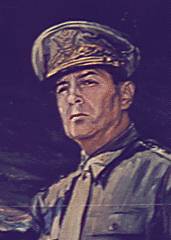 General
MacArthur served as the Commander of United States Forces Far East from 1941
until the end of the war in 1945. In 1941, he was forced out of the
Philippines by the Japanese and but said that he would return.
General
MacArthur served as the Commander of United States Forces Far East from 1941
until the end of the war in 1945. In 1941, he was forced out of the
Philippines by the Japanese and but said that he would return.
Once his forces were strong enough, he began a leap-frogging campaign, taking
certain Japanese-held islands while bypassing others and leaving them cut off
from the rest of the Japanese army and navy. MacArthur did return to the
Philippines in 1944. In 1945, he was assigned the task of commanding the
invasion of Japan itself, but Japan's surrender made the invasion unnecessary.
After the War, he became the American leader of occupied Japan, and in
1950-51, led UN forces in the Korean War before being relieved of command by
President Truman. Subsequently, he gave an unprecedented speech to a joint
session of Congress in which he made his famous statement that "old soldiers
never die, they just fade away." MacArthur died in 1964.
Bernard Montgomery - (Great Britain)
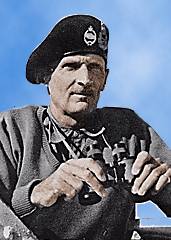 Great
Britain's most famous commander of World War II, Bernard Montgomery would end
the war with the rank of Field Marshall. Montgomery's most famous action came
in 1942, when he led the British Eighth Army in expelling General Erwin Rommel
and the German Afrika Corps out of North Africa. He also led the British
forces during the Normandy Invasion, but received a lot of criticism for his
slowness in taking the French town of Caen.
Great
Britain's most famous commander of World War II, Bernard Montgomery would end
the war with the rank of Field Marshall. Montgomery's most famous action came
in 1942, when he led the British Eighth Army in expelling General Erwin Rommel
and the German Afrika Corps out of North Africa. He also led the British
forces during the Normandy Invasion, but received a lot of criticism for his
slowness in taking the French town of Caen.
Chester Nimitz - (United States)
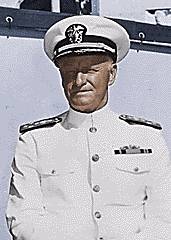 Admiral
Chester Nimitz served at Commander-in-Chief US Pacific Fleet from just after
Pearl Harbor until the end of the war. He planned the attack against
Yamamoto's fleets at the Battle of Midway Island and naval offensive
operations in the Pacific for the remainder of the war.
Admiral
Chester Nimitz served at Commander-in-Chief US Pacific Fleet from just after
Pearl Harbor until the end of the war. He planned the attack against
Yamamoto's fleets at the Battle of Midway Island and naval offensive
operations in the Pacific for the remainder of the war.
George S. Patton - (United States)
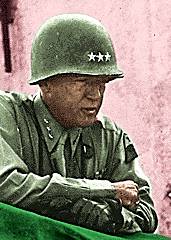 No
U. S. General was more controversial during World War II than George S.
Patton. He served in the cavalry in the early part of the 20th century and was
an early convert to tank warfare, and served as a tank brigade commander in
World War I. He commanded a Corps in North Africa and planned the invasion of
Sicily in 1943. He was known as a harsh commander (his nickname was "old blood
and guts"), even slapping a soldier whom he thought exhibited cowardice, an
incident that nearly got him fired. In 1944, Patton was the commander of a
fake U. S. Army group used to trick the Germans into believing he would be
leading the invasion of Europe at the Pas-de-Calais. The trick worked, and
allied forces successfully landed at Normandy on June 6, 1944.
No
U. S. General was more controversial during World War II than George S.
Patton. He served in the cavalry in the early part of the 20th century and was
an early convert to tank warfare, and served as a tank brigade commander in
World War I. He commanded a Corps in North Africa and planned the invasion of
Sicily in 1943. He was known as a harsh commander (his nickname was "old blood
and guts"), even slapping a soldier whom he thought exhibited cowardice, an
incident that nearly got him fired. In 1944, Patton was the commander of a
fake U. S. Army group used to trick the Germans into believing he would be
leading the invasion of Europe at the Pas-de-Calais. The trick worked, and
allied forces successfully landed at Normandy on June 6, 1944.
After the Normandy Invasion, Patton led the U. S. Third Army in France
advancing rapidly and keeping the pressure on the Germans. At the Battle of
the Bulge, he disengaged his entire army, turned them, and marched to the
relief of the besieged Americans at Bastogne---a feat that is still considered
one of the greatest in military history. His Army crossed the Rhine in March
1945, and would be in Czechoslovakia when the war concluded. He died in
December 1945 from injuries sustained in a car accident.


 Winston
Churchill became Prime Minister of Great Britain in 1940, replacing the
ineffective Neville Chamberlain. As war leader in Britain, Churchill helped
the Soviet Union when Germany launched its invasion of the communist country
in 1941, and he forged a strong, personal relationship with United States
President Franklin Roosevelt, from whom Britain received much needed aid in
the early years of the conflict and before America was officially at war with
Germany or Japan.
Winston
Churchill became Prime Minister of Great Britain in 1940, replacing the
ineffective Neville Chamberlain. As war leader in Britain, Churchill helped
the Soviet Union when Germany launched its invasion of the communist country
in 1941, and he forged a strong, personal relationship with United States
President Franklin Roosevelt, from whom Britain received much needed aid in
the early years of the conflict and before America was officially at war with
Germany or Japan. In
1941, when the United States was drawn in to World War II with the sneak
attack on Pearl Harbor by the Japanese, President Franklin Roosevelt was in
the 1st year of an unprecedented third term as President. After the attack on
Pearl Harbor, Roosevelt addressed Congress, giving one of his most famous
speeches, in which he said, "we have nothing to fear but fear itself."
In
1941, when the United States was drawn in to World War II with the sneak
attack on Pearl Harbor by the Japanese, President Franklin Roosevelt was in
the 1st year of an unprecedented third term as President. After the attack on
Pearl Harbor, Roosevelt addressed Congress, giving one of his most famous
speeches, in which he said, "we have nothing to fear but fear itself."  Josef
Stalin, the Soviet Union's war leader during World War II (the Great Patriotic
War to the Soviets), came to power after the death of Vladamire Lenin in the
late 1920s. He was a harsh and brutal dictator. In 1937-38, he purged his
military of its best officers, an act that would deprive him of competent
leadership once the war started. In 1939, Stalin and Adolf Hitler signed the
Nazi-Soviet Non-aggression Treaty that, besides declaring one country would
not go to war with the other, divided Poland between Germany and the Soviet
Union.
Josef
Stalin, the Soviet Union's war leader during World War II (the Great Patriotic
War to the Soviets), came to power after the death of Vladamire Lenin in the
late 1920s. He was a harsh and brutal dictator. In 1937-38, he purged his
military of its best officers, an act that would deprive him of competent
leadership once the war started. In 1939, Stalin and Adolf Hitler signed the
Nazi-Soviet Non-aggression Treaty that, besides declaring one country would
not go to war with the other, divided Poland between Germany and the Soviet
Union.  Dwight
D. Eisenhower graduated from West Point Military Academy in 1915 and rose
quickly through the ranks of the United States Army. At the outbreak of World
War II, Eisenhower was named Chief of Staff to George C. Marshall. In 1942,
Marshall sent Eisenhower to Great Britain to command American forces there and
in Europe. He commanded the North African Landings (Operation Torch), the
Normandy Invasion (Operation Overlord), and the offensive against Germany in
Western Europe.
Dwight
D. Eisenhower graduated from West Point Military Academy in 1915 and rose
quickly through the ranks of the United States Army. At the outbreak of World
War II, Eisenhower was named Chief of Staff to George C. Marshall. In 1942,
Marshall sent Eisenhower to Great Britain to command American forces there and
in Europe. He commanded the North African Landings (Operation Torch), the
Normandy Invasion (Operation Overlord), and the offensive against Germany in
Western Europe.  General
MacArthur served as the Commander of United States Forces Far East from 1941
until the end of the war in 1945. In 1941, he was forced out of the
Philippines by the Japanese and but said that he would return.
General
MacArthur served as the Commander of United States Forces Far East from 1941
until the end of the war in 1945. In 1941, he was forced out of the
Philippines by the Japanese and but said that he would return.  Great
Britain's most famous commander of World War II, Bernard Montgomery would end
the war with the rank of Field Marshall. Montgomery's most famous action came
in 1942, when he led the British Eighth Army in expelling General Erwin Rommel
and the German Afrika Corps out of North Africa. He also led the British
forces during the Normandy Invasion, but received a lot of criticism for his
slowness in taking the French town of Caen.
Great
Britain's most famous commander of World War II, Bernard Montgomery would end
the war with the rank of Field Marshall. Montgomery's most famous action came
in 1942, when he led the British Eighth Army in expelling General Erwin Rommel
and the German Afrika Corps out of North Africa. He also led the British
forces during the Normandy Invasion, but received a lot of criticism for his
slowness in taking the French town of Caen.  Admiral
Chester Nimitz served at Commander-in-Chief US Pacific Fleet from just after
Pearl Harbor until the end of the war. He planned the attack against
Yamamoto's fleets at the Battle of Midway Island and naval offensive
operations in the Pacific for the remainder of the war.
Admiral
Chester Nimitz served at Commander-in-Chief US Pacific Fleet from just after
Pearl Harbor until the end of the war. He planned the attack against
Yamamoto's fleets at the Battle of Midway Island and naval offensive
operations in the Pacific for the remainder of the war.  No
U. S. General was more controversial during World War II than George S.
Patton. He served in the cavalry in the early part of the 20th century and was
an early convert to tank warfare, and served as a tank brigade commander in
World War I. He commanded a Corps in North Africa and planned the invasion of
Sicily in 1943. He was known as a harsh commander (his nickname was "old blood
and guts"), even slapping a soldier whom he thought exhibited cowardice, an
incident that nearly got him fired. In 1944, Patton was the commander of a
fake U. S. Army group used to trick the Germans into believing he would be
leading the invasion of Europe at the Pas-de-Calais. The trick worked, and
allied forces successfully landed at Normandy on June 6, 1944.
No
U. S. General was more controversial during World War II than George S.
Patton. He served in the cavalry in the early part of the 20th century and was
an early convert to tank warfare, and served as a tank brigade commander in
World War I. He commanded a Corps in North Africa and planned the invasion of
Sicily in 1943. He was known as a harsh commander (his nickname was "old blood
and guts"), even slapping a soldier whom he thought exhibited cowardice, an
incident that nearly got him fired. In 1944, Patton was the commander of a
fake U. S. Army group used to trick the Germans into believing he would be
leading the invasion of Europe at the Pas-de-Calais. The trick worked, and
allied forces successfully landed at Normandy on June 6, 1944.